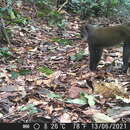Biology
provided by Arkive
The diet of this diurnal species consists of fruits, seeds, herbaceous plants, insects and small vertebrate prey (8). Although spending much of their time on the ground during the day, groups will sleep in the canopy, 10 to 15 meters above the ground (9). Mean group size for this species is 17 individuals (8) (10), consisting of one male and multiple females, although solitary males are known to occur (6) (8). The sun-tailed monkey has a polygynous mating system (9), and adult males will actively defend their groups from other males trying to usurp them (11). Whilst males disperse from their natal group, females remain, and a dominance hierarchy exists amongst these females, which is subsequently inherited by their offspring (11). The sun-tailed monkey gives birth to a single offspring, and the age of first reproduction for females is about 4 years old (9).
Conservation
provided by Arkive
The Gabonese government declared the sun-tailed monkey as a fully protected species in 1994 (5), and it is now considered a flagship species for conservation in Gabon (2). The future of this species rests with its protection within its range, and of its habitat. It will be important to determine this primate's distribution more precisely, and monitor the planned logging operation in the Foret des Abeilles and Lope closely (5).
Description
provided by Arkive
The sun-tailed monkey was first described in 1986 (1). It is a close relative of L'Hoest's Monkey, (Cercopithecus lhoesti), and Preuss's monkey (C. preussi), and in many ways resembles these primates with their dark grey coats, white markings, and long tails (4) (5).
Habitat
provided by Arkive
Inhabits hilly primary and secondary moist evergreen forest (1) (2). The sun-tailed monkey is a predominantly terrestrial primate (7).
Range
provided by Arkive
This species is endemic to Gabon, West Africa (4). It has a fragmented distribution area estimated at about 10,300 km², mainly centred in the Foret des Abeilles in central Gabon (6). This range is limited to the north and east by the Ogooue, Lolo and Bouenguidi rivers though it is not clear to what extent this primate occurs to the west and south of the Foret des Abeilles (6). More recent research suggests that this species occurs in the southern parts of the Lope National Park (5).
Status
provided by Arkive
Classified as Vulnerable (VU B1+2abcde, C1) on the IUCN Red List 2004 (1), and listed on Appendix II of CITES (3).
Threats
provided by Arkive
This monkey has a restricted range and is therefore highly at risk from habitat loss and fragmentation (1). While the area of Lope is relatively well protected, the Foret des Abeilles has been opened up to timber exploitation (5). As the forests become accessible for logging, the wildlife becomes more susceptible to hunting by locals for meat. In addition, the sun-tailed monkey is semi-terrestrial and so is at risk from being trapped in ground snares (5).

